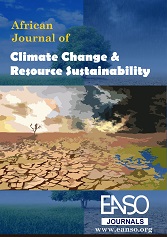Effects of Changing Weather Patterns on Household Food Availability in Bukiro Sub County Mbarara District
Résumé
Changing weather patterns and their variables are already negatively impacting food security by damaging crops, reducing yields, and increasing the prevalence of pests and diseases. These pests and diseases contend with crops for sunlight, water, and nutrients, further diminishing agricultural yields and creating issues for crops that were previously unexposed to these threats. Climate-related disruptions in food distribution and transportation, both internationally and domestically, have a substantial impact on not just safety and quality but also access to food. Prolonged dry spells followed by heavy and stormy rains cause interruptions in food production and transportation, reducing farmers' ability to get their grains to market and potentially affecting food prices. This study assessed farmers’ perceptions of effects of changing weather patterns on food security and their coping strategies towards effects of weather changing patterns in smallholder households in Bukiro Sub County, Mbarara District. A sample of 100 smallholder farmers were randomly selected from four parishes of Bukiro sub county and studied using questionnaire and observations. Key informants Interviews were also conducted with nine technical workers and three opinion leaders. Software STAT 26 and Ms excel version 2016 were used to do data analysis. The study found out that changing weather patterns through its variables specifically heavy and stormy rains, late of set of rains, and prolonged dry spells had significant effects on food security. The perceived effects of changing weather patterns established were drying up of water sources (83.8%), decreased land for crop growing (82.4%), reduction in crop yields (77.7%), drying of pastures for animals (67.4%), drying of crops (58.1%), and occurrence of crop and livestock pests and diseases at (56.6%). Also, the perceived weather changing variabilities were late onset of rains (60.1%), prolonged dry spells were responded at 17.6%, and heavy and stormy rains 22.3%. From the study finding farmers clearly perceived that changing weather patterns had negative effects smallholders’ agricultural production systems impacting negatively on food security
##plugins.generic.usageStats.downloads##
Références
Apanovich, N., & Mazur, R. E. (2018). Determinants of seasonal food security among smallholder farmers in south-central Uganda. Agriculture and Food Security, 7(1). https://doi.org/10.1186/s40066-018-0237-6
Brown, M. E., Antle, J. M., Backlund, P., Carr, E. R., Easterling, W. E., Walsh, M. K., Ammann, C., Attavanich, W., Barrett, C. B., Bellemare, M. F., Dancheck, V., Funk, C., Grace, K., Ingram, J. S. I., Jiang, H., Maletta, H., Mata, T., Murray, A., Ngugi, M., … Tebaldi, C. (2015). Climate Change, Global Food Security, and the U.S. Food System. https://doi.org/10.7930/J0862DC7
Danandeh Mehr, A., Sorman, A. U., Kahya, E., & Hesami Afshar, M. (2020). Climate change impacts on meteorological drought using SPI and SPEI: case study of Ankara, Turkey. Hydrological Sciences Journal, 65(2), 254–268. https://doi.org/10.1080/02626667.2019.1691218
El Bilali, H., Bassole, I. H. N., Dambo, L., & Berjan, S. (2020). Climate change and food security. Agriculture and Forestry, 66(3), 197–210. https://doi.org/10.17707/AgricultForest.66.3.16
FAO. (2014). Agroecology for food security and nutrition: proceedings of the FAO International Symposium: 18-19 September 2014, Rome, Italy. Food and agriculure organisation.
FAO. (2015). Climate change and food security: risks and responses.
Fao. (2018). Pastoralism in Africa’s drylands Reducing risks, addressing vulnerability and enhancing resilience.
Hatfield, J., Takle, G., Grotjahn, R., Holden, P., Izaurralde, R. C., Mader, T., Marshall, E., & Liverman, D. (2014). Ch. 6: Agriculture. Climate Change Impacts in the United States: The Third National Climate Assessment (J. M. Melillo, T. (T. C.) Richmond, & G. W. Yohe, Eds.). https://doi.org/10.7930/J02Z13FR
Ma, F. (2015). A Review of Research Methods in EFL Education. Theory and Practice in Language Studies, 5(3), 566. https://doi.org/10.17507/tpls.0503.16
Mbolanyi, B., Egeru, A., & Mfitumukiza, D. (2017). Choice options to meet household food security in the cattle corridor of Uganda. Environment and Natural Resources Journal, 15(1), 19–29. https://doi.org/10.14456/ennrj.2017.2
McSweeney, C., New, M., Lizcano, G., & Lu, X. (2010). The UNDP climate change country profiles. Bulletin of the American Meteorological Society, 91(2), 157–166. https://doi.org/10.1175/2009BAMS2826.1
Mfitumukiza, D., Barasa, B., Kiggundu, N., Nyarwaya, A., Muzei, J. P., Box, P. O., & Kampala, U. (2020). Smallholder farmers’ perceived evaluation of agricultural drought adaptation technologies used in Uganda: constraints and opportunities 1*. https://www.elsevier.com/open-access/userlicense/1.0/
MoWE. (2010). Climate Change in Uganda Insights for Long term Adaptation and Building Community Resilience N M ENT A L A L E RT.
Mukasa, J., Olaka, L., & Said, M. Y. (2020). Drought and households’ adaptive capacity to water scarcity in Kasali, Uganda. Journal of Water and Climate Change, 11(S1), 217–232. https://doi.org/10.2166/wcc.2020.012
Nuwagaba, A., & Namateefu, L. K. (2013). Climatic Change, Land Use and Food Security in Uganda: A Survey of Western Uganda. In Journal of Earth Sciences and Geotechnical Engineering (Vol. 3, Issue 2). online) Scienpress Ltd.
WFP. (2012). Climate impacts on food security and nutrition.
Ziska, L., Crimmins, A., Auclair, A., DeGrasse, S., Garofalo, J. F., Khan, A. S., Loladze, I., Pérez de León, A. A., Showler, A., Thurston, J., & Walls, I. (2016). Ch. 7: Food Safety, Nutrition, and Distribution. The Impacts of Climate Change on Human Health in the United States: A Scientific Assessment. https://doi.org/10.7930/J0ZP4417
Copyright (c) 2024 John Francis Nuwasasira, Ewaechabo Tiyo Christopher, Wycliffe Tumwesigye, Agnes Tusingwire

Ce travail est disponible sous la licence Creative Commons Attribution 4.0 International .




























